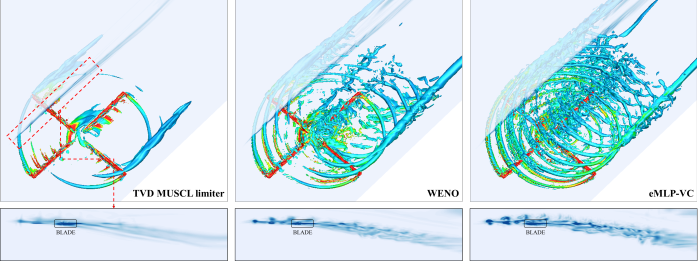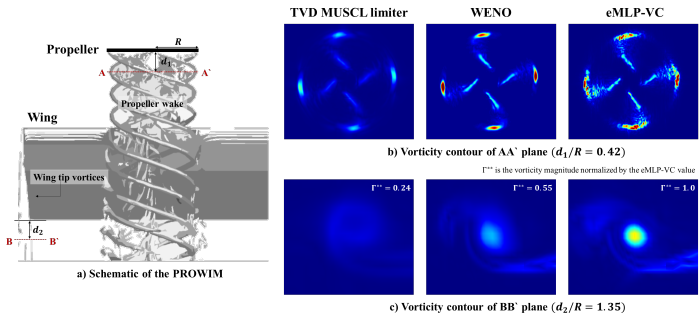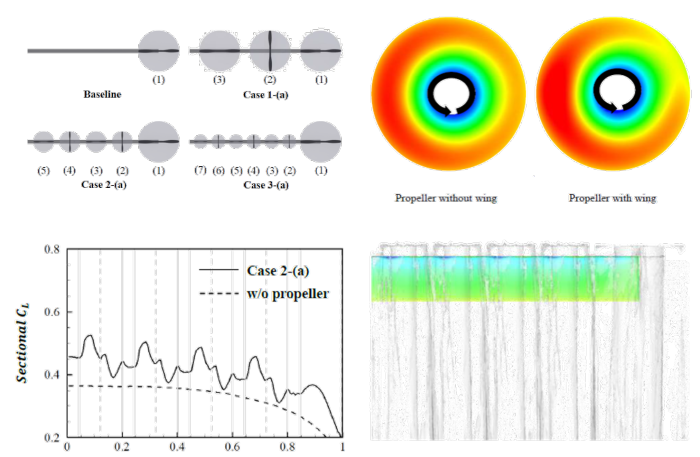High Resolution Numerical Method
High Resolution Numerical Method
A recent growing interest in Urban Air Mobility (UAM) worldwide has led to the demand for physical analysis of the aerodynamic performance and aeroacoustic characteristics of electric Vertical Take-Off and Landing(eVTOL) rotorcraft. In UAM eVTOL rotorcraft, the smaller vortices generated from multiple propulsors complicately interact with lifting surfaces such as wings, fuselage, and propellers. Therefore, for the accurate performance and noise prediction of UAM eVTOL rotorcraft, vortices should be preserved with few dissipation, and their interactions must be modeled precisely. This requires a numerical algorithm with a more refined resolution than allowed by conventional schemes. eMLP-VC (enhanced Multi-dimensional Limiting Process for Vorticity Conservation) exhibits superior resolution, numerical stability, and computational time efficiency compared to the conventional high-order schemes.


Actuator Disk Method
Rotorcrafts have the inherent aeromechanical complexity of a rotor system by the rotating blades. Particularly in descent and in maneuvering flight, the strong vortices trailed from the tips of the rotor blades are often convected backwards and through the rotor disk. Therefore, time efficient and an accurate estimation of the unsteady aerodynamic characteristics is essential to successful design and development of a helicopter. Actuator disk method(ADM) describes the propeller as propeller force components through disk form which enables to make a grid system efficiently due to the simple grid. As the source term is added explicitly, local velocity and density are used to calculate the local force components via Blade Element Theory (BET).

Hybrid CFD (CFD + free-wake model)
Rotorcrafts have the inherent aeromechanical complexity of a rotor system by the rotating blades. Particularly in descent and in maneuvering flight, the strong vortices trailed from the tips of the rotor blades are often convected backwards and through the rotor disk. Therefore, time efficient and an accurate estimation of the unsteady aerodynamic characteristics is essential to successful design and development of a helicopter. The hybrid CFD methodology uses the Euler/NS equations to solve the flow near the blade surface, but the effect of the far wake is computed through the wake model. The hybrid CFD methodology is computationally efficient. Its wake modeling approach is non-dissipative, making it an attractive tool to study rotorcraft aeromechanics. Relaxation free wake module provides induced velocity about all calculation domain using Field Velocity Approach. CFD calculates the vortex strength of all wake filaments.
Reference
[1] Hong, Yoonpyo, et al. "Enhanced high-order scheme for high-resolution rotorcraft flowfield analysis." AIAA Journal 60.1 (2022): 144-159.
[2] Seo, Youngrock, Yoonpyo Hong, and Kwanjung Yee. "Numerical investigation of wing-multiple propeller aerodynamic interaction using actuator disk method." International Journal of Aeronautical and Space Sciences 23.5 (2022): 805-822.